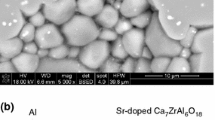Abstract
The influence of polyepoxysuccinic acid(PESA) on the solid phase products in hydrated Portland cement pastes was investigated by isothermal calorimetry, X-ray diffraction(XRD), 29Si and 27Al nuclear magnetic resonance(NMR). The results indicated that PESA bonds Ca2+ ions in pore solution to prevent portlandite formation, and also combines with Ca2+ ions on the surface of silicate minerals to prolong the control time of phase boundary reaction process, leading to the retardation of silicate mineral hydration. Meanwhile, the interlayer Ca2+ ions in Jennite-like structure bridging PESA and C-S-H gels prevent silicate tetrahedron and aluminum tetrahedron from occupying the sites of bridging silicate tetrahedron, which causes the main existence of dimer in C-S-H structure, deceases the degree of Al3+ substituting for Si4+ and promotes the transformation from 4-coordination aluminum to 6-coordination aluminum. Furthermore, the -Ca+ chelating group from reacting PESA with Ca2+ ions combines easily with SO42- ions, resulting in transformation from ettringite, AFm to TAH(Third aluminum hydrate). However, with the higher addition of PESA, it will bridge the excess PESA by Ca2+ ions to form a new chelate with ladder-shaped double chains structure, which not only reduces the amount of PESA bonding Ca2+ ions, but also decreases its solidifying capability for SO42- ions, leading to the transformation from TAH to AFm or ettringite. Meanwhile, at later hydration, the inhibition effect of PESA on cement hydration is weakened, and the transformation degree from TAH to AFm is higher than that to AFt with the addition of PESA.
Similar content being viewed by others
References
Cody R D. Organo-crystalline Interactions in Evaporite Systems: The Effects of Crystallization Inhibition[J]. J. Sediment. Petrol., 1991, 61(5): 704–718
Robert D C, Cody R D, Cody A M, et al. Reduction of Concrete Deterioration by Ettringite Using Crystal Growth Inhibition Techniques[R]. Iowa DOT TR-431, 2001
Coveney P V, Davey R J, Griffin J L W, et al. Molecular Design and Testing of Organophosphonates for Inhibition of Crystallization of Ettringite and Cement Hydration[J]. Chem. Commun., 1998: 1467–1468
Cody A M, Lee H, Cody R D, et al. The Effects of Chemical Environment on the Nucleation, Growth, and Stability of Ettringite[-Ca3Al(OH)6]2(SO4)3·26H2O][J]. Cem. Concr. Res., 2004, 34(5): 869–881
Ma Z C. Synthesis and Performance of an Ettringite Crystallization Inhibitor[D]. Beijing: China Building Materials Academy, 2010 (in Chinese)
YAN P Y, ZHENG F. Kinetics Model for the Hydration Mechanism of Cementitious Materials[J]. J. Chin. Ceram. Soc., 2006, 34(5): 555–559 (in Chinese)
KRSTULOVIC R, DABIC P. A Conceptual Model of the Cement Hydration Process[J]. Cem. Concr. Res., 2000, 30(5): 693–698
Richardson I G, Brough A R, Brydson R, et al. Location of Aluminum in Substituted Calcium Silicate Hydrate (C-S-H) Gels as Determined by 29Si and 27Al NMR and EELS[J]. J. Am. Ceram. Soc., 1993, 76(9): 2285–2288
Justnes H, Meland I, Bjoergum J O, et al. NMR-a Powerful Tool in Cement and Concrete Research[J]. Adv. Cem. Res., 1990, 3(11): 105–110
Jakobsen A, Anderson S, Jakobsen H J. Characterization of White Portland Cement Hydration and the C-S-H Structure in the Presence of Sodium Aluminate by 27Al and 29Si MAS NMR Spectroscopy[J]. Cem. Concr. Res., 2004, 34(5): 857–868
Hu C G, Ding Q J, Hu S G, et al. Effect of Sulfate Ions on Distribution of Al3+ Coordination in Hardened Cement Pastes at Variable Temperature[J]. J. Func. Mater., 2014, 2(45): 02142–02146. (in Chinese)
Hu C G, Hu S G, Ding Q J, et al. Effect of Curing Regime on Degree of Al3+ Substituting for Si4+ in C-S-H Gels of Hardened Portland Cement Pastes[J]. Journal of Wuhan University of Technology-Mater. Sci. Ed., 2014, 29(3): 546–552
Elkhadiri I, Puertas F. The Effect of Curing Temperature on Sulphate-resistant Cement Hydration and Strength[J]. Constr. Build. Mater., 2008, 22(7): 1331–1341
Grimmer A R. Structural Investigation of Calcium Silicates from 29Si Chemical Shift Measurements[M]. In: P Colombet, A-R Grimmer (Eds.), Application of NMR Spectroscopy to Cement Science, London: Gordon and Breach, 1994
Skibsted J, Henderson E, Jakobsen H J. Characterization of Calcium Aluminate Phases in Cements by 27Al MAS NMR Spectroscopy[J]. Inorg. Chem., 1993, 32(6): 1013–1027
Andersen M D, Jakobsen H J, Skibsted J. Incorporation of Aluminum in the Calcium Silicate Hydrate (C-S-H) of Hydrated Portland Cements: A High-field 27Al and 29Si MAS NMR Investigation[J]. Inorg. Chem., 2003, 42 (7): 2280–2287
Andersen M D, Jakobsen H J, Skibsted. A New Aluminium-hydrate Species in Hydrated Portland Cements Characterized by 27Al and 29Si MAS NMR Spectroscopy[J]. Cem. Concr. Res., 2006, 36(1): 3–17
Taylor H F W. Hydrated Calcium Silicates. Part I. Compound Formation at Ordinary Temperatures[J] J. Chem. Soc., 1950: 3682–3690
Author information
Authors and Affiliations
Corresponding author
Additional information
Funded by the Major State Basic Research Development Program of China (973 Program) (No. 2015CB655101), Hubei Key Laboratory of Roadway Bridge and Structure Engineering (Wuhan University of Technology) (No. DQZDJJ201504), State Key Laboratory of High Performance Civil Engineering Materials (No. 2015CEM006), Natural Science Foundation of Hebei Province (No. E2016209283), Science and Technology Program of Hebei Province (No. 16273706D)
Rights and permissions
About this article
Cite this article
Hu, C., Wang, X., Bai, R. et al. Influence of Polyepoxysuccinic Acid on Solid Phase Products in Portland Cement Pastes. J. Wuhan Univ. Technol.-Mat. Sci. Edit. 33, 1140–1149 (2018). https://doi.org/10.1007/s11595-018-1946-1
Received:
Accepted:
Published:
Issue Date:
DOI: https://doi.org/10.1007/s11595-018-1946-1




